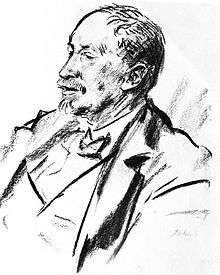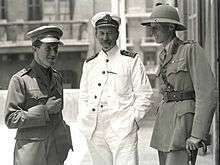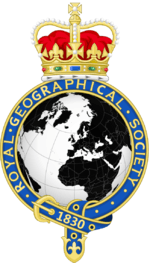David George Hogarth
| David George Hogarth | |
|---|---|
|
David George Hogarth (centre), with T. E. Lawrence (left) and Lt Col. Dawnay at the Arab Bureau, Cairo, May 1918 | |
| Born |
23 May 1862 Barton-upon-Humber, Lincolnshire, England |
| Died |
6 November 1927 (aged 65) Oxford, Oxfordshire, England |
| Nationality | United Kingdom |
| Fields | Archaeology, classics, education, journalism, fund directorship, museum curatorship, intelligence operations and directorship, diplomacy |
| Institutions | British School at Athens, Ashmolean Museum |
| Alma mater | Oxford University |
| Influences | Arthur Evans |
| Influenced | T. E. Lawrence |
| Spouse | Laura Violet (Hogarth) Uppleby |
David George Hogarth CMG (23 May 1862 – 6 November 1927) was a British archaeologist and scholar associated with T. E. Lawrence and Arthur Evans.
Biography
D. G. Hogarth was the son of Reverend George Hogarth, Vicar of Barton-upon-Humber, and Jane Elizabeth (Uppleby) Hogarth. He had a sister three years younger, Janet E. Courtney, an author and feminist. In one of his autobiographical works, Hogarth claimed to be an antiquary who was made so, rather than born to it. He said, "nothing disposed me to my trade in early years." Those years included a secondary education, 1876–1880, at Winchester College, which claims to be, and was labelled by Hogarth as, "our oldest Public School."[1]
Between 1887 and 1907, Hogarth travelled to excavations in Cyprus, Crete, Egypt, Syria, Melos, and Ephesus (the Temple of Artemis).[2] On the island of Crete, he excavated Zakros and Psychro Cave. Hogarth was named director of the British School at Athens in 1897 and occupied the position until 1900.[3] He was the keeper of the Ashmolean Museum in Oxford from 1909[4] until his death in 1927.[5][6]
In 1915, during the First World War, Hogarth was commissioned with the temporary rank of lieutenant commander in the Royal Naval Volunteer Reserve[7] and joined the Geographical Section of the Naval Intelligence Division. Professor Hogarth was appointed the acting director of the Arab Bureau, for a time during 1916 when Sir Mark Sykes went back to London. Kinahan Cornwallis was his deputy. Hogarth was close with T. E. Lawrence and worked with Lawrence to plan the Arab Revolt.[8] He was appointed a Companion of the Order of St Michael and St George in the 1918 New Year Honours for his efforts during the First World War.[9] Sykes befriended Hogarth, who had described India Government as believing they had an moral imperative to the British Raj as the best form of government and could not fail in their duty to impose it on a Province of Mesopotamia. The Arabists rejected this proposal vehemently; Sykes taking Hogarth's research as evidence of the uniquely different situation in the protectorate. The archaeologists knew it was clear that the Raj had no understanding of the different conditions, that there needed to be a specific "Arab Policy" for what had become a frontier of empire.[10]

From 1925 to 1927 he was President of the Royal Geographical Society.[11]
On 7 November 1894, Hogarth married Laura Violet Uppleby, daughter of George Charles Uppleby.[12] His wife and mother shared a common great great grandfather, one John Uppleby of Wootton, Lincolnshire.[13] Laura Violet was 26 at the time; David George, 32. They had one son, William David Hogarth (1901–1965).[14]
See also
Bibliography
By Hogarth
- Hogarth, David George (1889). Devia Cypria: notes of an archaeological journey in Cyprus in 1888. London: H. Frowde.
- —— (1896). The wandering scholar in the Levant (2nd ed.). London: J. Murray.
- —— (1897). Philip and Alexander of Macedon: two essays in biography. New York: C. Scribner's Sons.
- The Nearer East (1905)
- —— (1904). The penetration of Arabia : a record of the development of Western knowledge concerning the Arabian peninsula. London: Lawrence and Bullen.
- The Archaic Artemisia of Ephesus (1908)
- —— (1909). Ionia and the East; six lectures delivered before the University of London. Oxford: Clarendon Press.
- —— (1910). Accidents of an antiquary's life. London: MacMillan and Co., Limited.
- The Ancient East (1914)
- The Balkans (1915)
- —— (1920). Hittite seals, with particular reference to the Ashmolean collection. Oxford: Clarendon Press.
- Arabia (1922) (also as A History of Arabia)
- Kings of the Hittites (1926) (Schweich Lectures for 1924)
- The Life of Charles M. Doughty (1928)
With Hogarth as editor
- Authority and Archaeology – Sacred and Profane – Essays on the relation of monuments to Biblical and Classical Literature (1899 2nd Edition)
References
- ↑ Hogarth 1910, pp. 1–2.
- ↑ "HOGARTH, David George". Who's Who. Vol. 59. 1907. p. 855.
- ↑ "BSA Managing Committee (1886-1918)". History of the British School at Athens. Retrieved 31 August 2016.
- ↑ It was at the Ashmolean in early 1909 that Hogarth first met T. E. Lawrence – Wilson, Jeremy (1989) Lawrence of Arabia p.53 – ( see also long footnote on p.987-988 where Robert Graves in his 1927 work Lawrence and the Arabs had an account of the meeting as January 1909 )
- ↑ M, J. L. (1927) Dr. D. G. Hogarth, C.M.G M, J. L Nature Vol: 120 Issue: 3029 ISSN 0028-0836 Date: 1927 Pages: 735 – 737, "...By the unexpected death of Dr. David George Hogarth (6 Nov.), geography and archaeology lost briefly their most distinguished representatives in Great Britain ..."
- ↑ "DEATH OF ARCHAEOLOGIST.". The Brisbane Courier. Qld.: National Library of Australia. 8 November 1927. p. 15. Retrieved 2 May 2012.
- ↑ The London Gazette: no. 29348. p. 10763. 2 November 1915.
- ↑ "The Penetration of Arabia: A Record of the Development of Western Knowledge Concerning the Arabian Peninsula". World Digital Library. 1904. Retrieved 24 September 2013.
- ↑ The London Gazette: (Supplement) no. 30451. p. 82. 28 December 1917.
- ↑ James Onley, The Arabian Frontier of the British Raj (1921)
- ↑ "David George Hogarth". JSTOR. Retrieved 28 August 2013.
- ↑ Foster, J (1871). The pedigree of Wilson of High Wray & Kendal, and the families connected with them. Google Books.Google Books
- ↑ Ball, H.W. (1856). The social history and antiquities of Barton-upon-Humber. Google Books
- ↑ A summary of the family connections of Hogarth and his wife is to be found, with sources, at "David George Hogarth". ancestry.com. 2011.
Bibliography
- Graves, Robert (1927). Lawrence and the Arabs. London: Jonathan Cape.
- M. J. L. (1927). "Dr. D. G. Hogarth, C.M.G". Nature. 120 (3029): 735–737. doi:10.1038/120735a0.
- Onley, James (2007). The Arabian Frontier of the British Raj. New York: Oxford University Press.
- Townshend, Charles (2010). When God Made Hell: The British Invasion of Mesopotamia and the Creation of Iraq 1914-1921. Faber and Faber.
- Wilson, Jeremy (1989). Lawrence of Arabia.
External links
![]() Works written by or about David George Hogarth at Wikisource
Works written by or about David George Hogarth at Wikisource
- Works by David George Hogarth at Project Gutenberg
- Works by or about David George Hogarth at Internet Archive

